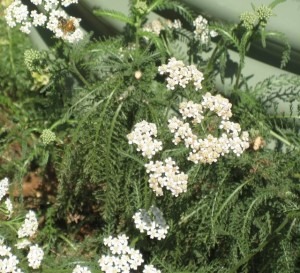“Garden plants are the biggest source of weeds in this country totalling 70% of Australia’s combined agricultural, noxious and natural ecosystem weeds”1. A more recent review of the literature and a survey of seed experts in Australia has revealed that the ornamental plant trade and vehicle movement are the major pathways for weed spread2. Thus the garden and nursery industry as well as home gardeners must take the blame for this problem which results in inhibition or even elimination of native plants and other species in natural areas. What can gardeners do to avoid this?
An environmental weed may be one that we recognise as a common garden weed, such as White Clover Trifolium repens or Soursob Oxalis pescapre. They can also be ornamental plants introduced from overseas, or Australian plants originating from outside the ‘local area,’ such as Bluebell Creeper Sollya hetrophylla from WA or Sweet Pittosporum Pittosporum undulatum from East Gippsland.
Volunteers and governments dedicate enormous resources to controlling invasive plants that destroy biodiversity in National Parks and Reserves. Weeds in the garden create a chore that needs to be attended to in order to keep our ornamental plants healthy and to make the garden more attractive. When plants become weeds in our bushland and waterways, however, they pose a much more serious problem.
Environmental weeds can be of any plant type: annuals, perennial herbs, shrubs, vines, trees, aquatics or succulents. Due to their ability to survive and spread over a wide range of conditions these plant species are identified and classed as environmental weeds.
Some of the plants that we grow in our gardens are able to propagate themselves readily by seeds, cuttings or offshoots. Examples include Agapanthus that spreads by seed, the berries from Cotoneaster spread by birds, and Ivy that can take root from a small piece of stem.
When they spread to natural areas, environmental weeds compete with the naturally occurring local vegetation for light, nutrients, water and space, often reducing its ability to regenerate. Their impacts on ecosystems can include reduced biodiversity, loss of food sources and shelter (for animals and insects) and even choking of rivers as has occurred with willows Salix spp.
What can we do?
Don’t plant weedy species
When deciding on what plant species to include in your home gardens please consider using plants without potential for weediness, especially if you live near areas of bushland, coast, rivers or creeks. There are many excellent alternatives to choose from and natural plant and animal communities may benefit from your actions. If you are not sure, ask at a garden centre that has SGA certification, contact your local council for information on weeds that are a problem in your area or visit http://www.environment.gov.au/biodiversity/invasive/weeds/
Use strategies to prevent spread
 When we move house, we are often confronted with existing plants with weed potential. But we might not want to rip them out, especially if they are attractive. And as we look for natural methods of pest control, we might want to attract beneficial insects into the garden by planting species that are known weeds in different parts of Australia e.g. Queen Anne’s lace Daucus caryota, yarrow Achillea filipendula and fennel Foeniculum vulgare. However, it is possible to have the benefits without the disadvantages:
When we move house, we are often confronted with existing plants with weed potential. But we might not want to rip them out, especially if they are attractive. And as we look for natural methods of pest control, we might want to attract beneficial insects into the garden by planting species that are known weeds in different parts of Australia e.g. Queen Anne’s lace Daucus caryota, yarrow Achillea filipendula and fennel Foeniculum vulgare. However, it is possible to have the benefits without the disadvantages:
- Choose sterile forms of species that set seed
- Consider replacing any environmental weeds in your garden with local plants or exotic plants that are not invasive
- Cut off old flower heads before they form berries or seedpods
- Contain self-seeding plants, such as coriander and fennel to a specific area of the garden
- Restrict the root growth of creeping or suckering species with root barriers i.e. metal sheeting dug 30 cm into the ground
- Grow aggressive creeping species, such as yarrow, in pots which have been lined with 2 layers of shade mesh or geofabric so that stolons and roots cannot escape
- Dispose of garden waste by composting or in the green waste collection
- Put particularly resistant species such as kikuyu in sealed plastic bags in the household garbage
- Avoid dumping weeds and prunings on vacant land, in waterways or the bush
- If you see someone dumping garden waste report it to your council
- Avoid transporting seeds or Australian plant material interstate or overseas, where it may become an environmental weed.
References
1. Groves, R H, Boden, R, Lonsdale, W M. (2005) Jumping the garden fence: Invasive Garden Plants in Australia and their environmental and agricultural impacts. WWF-Australia.
2. Coleman, M J, Sindel, B M. van der Meulen, A W, Reeve, I J. (2011) The Risks Associated with Weed Spread in Australia and Implications for Natural Areas. Natural Areas Journal, 31 (4), 368-376.
Related Articles:
Weed Control
Several different approaches are needed for weed control since eradication is difficult and can be expensive. Preventing weeds from establishing and…
Low Impact Pest Management 101 Video
Sustainable Gardening 101 Video Series PART 3: Low Impact Pest Management Gardens are the natural habitat for all types of insects – the good, the…



